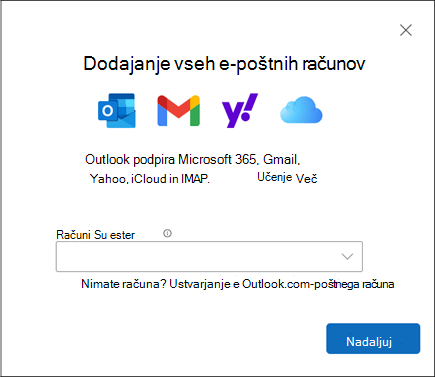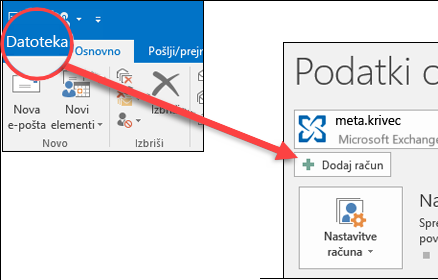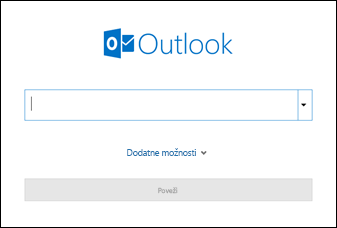Dodajanje e-poštnega računa v Outlook za Windows
Velja za
V storitev Outlook lahko dodate različne vrste e-poštnih računov, vključno z računom Outlook.com ali Hotmail.com, službenim ali šolskim računom, ki ga uporabljate za račune za Microsoft 365, Gmail, Yahoo, iCloud in Exchange.
Spodaj izberite možnost zavihka za različico Outlooka, ki jo uporabljate. Katero različico Outlooka imam?
Opomba: Če koraki v tem zavihku »Nov Outlook « ne delujejo, morda še ne uporabljate novega Outlooka za Windows. Izberite zavihek Klasični Outlook in namesto tega upoštevajte ta navodila.
V tem članku:
Dodajte nov račun | Nastavi kot primarni račun | Odstrani račun | Odpravljanje težav z geslom
Dodajanje novega računa v novi Outlook
-
Na zavihku Pogled izberite Nastavitve pogleda ali pa na zavihku Datoteka izberite Podatki o računu.
-
Izberite Računi > Vaši računi. Zdaj lahko dodate nov račun.
-
V razdelku E-poštniračuni izberite Dodaj račun in na spustnem meniju izberite predlagani račun ali pa vnesite drug e-poštni naslov. Izberite Nadaljuj.
Opomba: Nekateri ponudniki e-pošte, ki niso Microsoftovi, na primer Gmail, Yahoo in iCloud, zahtevajo, da spremenite nekatere nastavitve na njihovih spletnih mestih, preden lahko dodate te račune v Outlook.
-
Če ste pozvani, vnesite geslo za račun in izberite Dokončano.
Nastavi kot primarni račun v novem Outlooku
-
Na zavihku Pogled izberite Nastavitve pogleda ali pa na zavihku Datoteka izberite Podatki o računu > Računi > vaši računi.
-
V razdelku E-poštni računi poiščite račun, ki ga želite spremeniti ali izbrisati. Poleg imena računa izberite Upravljaj.
-
V razdelku Podrobnosti računa izberite Nastavi kot primarni račun.
-
Ko končate, izberite nazaj na stran z računi ali zaprite okno Nastavitve .
Odstranjevanje računa v novem Outlooku
-
Na zavihku Pogled izberite Nastavitve pogleda ali pa na zavihku Datoteka izberite Podatki o računu > Računi > vaši računi.
-
V razdelku E-poštni računi poiščite račun, ki ga želite izbrisati. Poleg imena računa izberite Upravljaj.
-
V razdelku Podrobnosti računa izberite Odstrani, da odstranite ta račun iz Outlooka. Vsa predpomnjena vsebina za ta račun bo izbrisana, ko odstranite račun.
Opomba: S tem korakom odstranite le račun iz programa Outlook, ne izbrišete pa računa. Če želite izbrisati račun, poiščite pomoč svojega ponudnika e-pošte.
-
Za račune, pri katerih Microsoft ni e-poštni ponudnik (na primer Gmail, Yahoo, iCloud in računi, ki niso Microsoftovi IMAP in POP), se prikaže okno Odstrani račun. Izberite možnost, da odstranite račun le iz te naprave ali vseh naprav.Če izberete Odstrani iz vseh naprav, bo vaš račun odstranjen iz vseh naprav, v katerih ste dodali svoj račun v Outlook.
-
Ko končate, izberite Nazaj na stran z računi ali zaprite okno Nastavitve.
Odpravljanje težav z geslom pri dodajanju računa v novi Outlook
Ste pozabili geslo
Če ste pozabili geslo za Microsoftov račun, uporabite našega orodja za pomoč pri vpisu, da se vrnete v svoj račun, ali pa si oglejte Ponastavitev pozabljenega gesla za Microsoftov račun.
Če ste pozabili geslo za službeni ali šolski račun, glejte Ponastavitev službenega ali šolskega gesla z varnostnimi podatki.
Sporočilo z geslom za aplikacijo
Če veste, da uporabljate pravilno geslo za svoj e-poštni račun, in se prikaže sporočilo, na primer:
-
Ustvarite geslo za program za Outlook na spletnem mestu ponudnika e-pošte.
Gesla za aplikacije so naključno ustvarjena z enkratno uporabo gesel, ki omogočajo začasen dostop do vaših spletnih računov. Začasna gesla delujejo kot varnostna plast in preprečujejo, da bi morali poverilnice glavnega računa dati v skupno rabo s potencialno manj varnimi ali neznanimi programi.
Odvisno od e-poštnega ponudnika bo morda potrebno geslo za aplikacijo, da boste lahko dodali določene vrste računov v nove in klasične Outlooke, kot sta računa IMAP ali iCloud.
Če želite dodati geslo za aplikacijo, naredite to:
-
Če želite pridobiti geslo za aplikacijo, se obrnite na ponudnika e-pošte. Vaš ponudnik e-poštnih storitev vam bo zagotovil navodila za ustvarjanje gesla za aplikacijo za uporabo v e-poštnih aplikacijah, kot sta novi in klasični Outlook, namesto rednega gesla. Navodila za storitev AOL so na primer na voljo v članku Ustvarjanje in upravljanje gesel za aplikacije drugih ponudnikov.
-
Ko od svojega ponudnika prejmete geslo za aplikacijo, ga kopirajte in prilepite, ko ste pozvani k vnosu gesla za račun v Outlooku.
Če želite pomoč za dodajanje računa za Gmail ali iCloud, glejte Dodajanje računa za Gmail ali Dodajanje ali upravljanje e-poštnega računa iCloud.
Vodena podpora v brskalniku lahko zagotovi digitalne rešitve za težave z Officeom
Ta navodila so enaka, ne glede na to, ali dodajate svoj prvi e-poštni račun ali dodatne e-poštne račune v klasični Outlook za Windows.
-
Izberite Datoteka > Dodaj račun.
(Če zavihek Datoteka ni prikazan , morda uporabljate Nov Outlook za Windows. Navodila najdete v razdelku Nov Outlook .«
-
Vnesite svoj e-poštni naslov in kliknite Poveži.
-
Če ste pozvani, znova vnesite geslo, nato pa izberite V redu > Dokončaj , da začnete uporabljati e-poštni račun v klasičnem Outlooku za Windows.
Odstranjevanje računa
Če e-poštni račun odstranite iz klasičnega Outlooka za Windows, e-poštnega računa ne dezaktivivite. Če želite dezaktivirati svoj račun, se obrnite na ponudnika e-poštnega računa. Ko izbrišete račun iz klasičnega Outlooka, ne boste več mogli pošiljati in prejemati pošte iz tega računa v Outlooku.
-
V klasičnem Outlooku za Windows izberite Datoteka.
-
Izberite Nastavitve računa > Nastavitve računa.
-
Izberite račun, ki ga želite izbrisati, in izberite Odstrani.
-
Prikaže se opozorilo, do bo izbrisana vsa predpomnjena vsebina za ta račun. To velja le za vsebino, ki je prenesena in shranjena v vašem računalniku.
-
Za potrditev kliknite Da.
Pomembno: Če želite izbrisati zadnji ali edini e-poštni račun, ki ga imate v klasičnem Outlooku za Windows, boste prejeli opozorilo, da morate za podatke ustvariti novo mesto, preden odstranite račun. Če želite več informacij, glejte Ustvarjanje Outlookove podatkovne datoteke.
Odpravljanje težav
Ste pozabili geslo
Če ste pozabili geslo za Microsoftov račun, uporabite našega orodja za pomoč pri vpisu, da se vrnete v svoj račun, ali pa si oglejte Ponastavitev pozabljenega gesla za Microsoftov račun.
Če ste pozabili geslo za službeni ali šolski račun, glejte Ponastavitev službenega ali šolskega gesla z varnostnimi podatki.
Sporočilo z geslom za aplikacijo
Če veste, da uporabljate pravilno geslo za svoj e-poštni račun, in se prikaže sporočilo, na primer:
-
Ustvarite geslo za program za Outlook na spletnem mestu ponudnika e-pošte.
Gesla za aplikacije so naključno ustvarjena z enkratno uporabo gesel, ki omogočajo začasen dostop do vaših spletnih računov. Začasna gesla delujejo kot varnostna plast in preprečujejo, da bi morali poverilnice glavnega računa dati v skupno rabo s potencialno manj varnimi ali neznanimi programi.
Odvisno od vašega ponudnika e-pošte bo morda potrebno geslo za aplikacijo, da boste lahko dodali določene vrste računov v nov in klasični Outlook za Windows, na primer račune IMAP ali iCloud.
Če želite pridobiti geslo za aplikacijo, se obrnite na ponudnika e-pošte. Vaš ponudnik e-poštnih storitev vam bo zagotovil navodila za ustvarjanje gesla za aplikacijo, tako da ga lahko uporabljate v e-poštnih aplikacijah, kot sta novi in klasični Outlook. Navodila za storitev AOL so na primer v tem članku na njihovem spletnem mestu: Ustvarjanje in upravljanje gesel za aplikacije drugih ponudnikov
Ko od svojega ponudnika prejmete geslo za aplikacijo, ga kopirajte in prilepite, ko ste pozvani k vnosu gesla za račun v klasičnem Outlooku.
Če želite pomoč za dodajanje računa za Gmail ali iCloud, glejte Dodajanje računa za Gmail ali Dodajanje ali upravljanje e-poštnega računa iCloud.
Uporaba naprednih nastavitev
Morda boste morali e-poštni račun dodati ročno. Izberite enega od spodaj navedenih naprednih načinov:
Uporaba naprednih nastavitev za dodajanje e-poštnega računa POP ali IMAP v klasični Outlook za Windows
Če morate vnesti določene vrednosti za imena strežnikov za dohodno in odhodno pošto, številke vrat ali nastavitve SSL, lahko uporabite Outlookovo možnost napredne nastavitve. S temi navodili lahko dodate račun POP ali IMAP v klasični Outlook.
-
Odprite klasični Outlook in izberite Datoteka >Dodaj račun.
-
Na naslednjem zaslonu vnesite svoj e-poštni naslov, izberite Dodatne možnosti, nato pa potrdite polje Dovoli mi, da ročno nastavim svoj račun in izberiteVzpostavi povezavo.
-
Izberite vrsto računa. Ko boste v večini primerov morali uporabiti to možnost, boste izbrali IMAP.
-
Na zaslonu Nastavitve računa bi morala biti vnaprej izpolnjena večina nastavitev računa, ki jih potrebujete. Če pa morate preveriti nastavitve, glejte temo z nastavitvami računa POP in IMAP . Vnesite nastavitve strežnika za dohodno in odhodno pošto in nato izberite Naprej.
-
Vnesite geslo in nato izberite Poveži.
Uporaba napredne nastavitve za dodajanje e-poštnega računa MAPI neodvisnega izdelovalca v klasični Outlook za Windows
Če uporabljate neodvisnega ponudnika MAPI, prenesite in konfigurirajte aplikacijo ponudnika e-pošte MAPI, kot predlaga podjetje ponudnika.
-
Odprite klasični Outlook in izberite Datoteka > Dodaj račun.
-
Na naslednjem zaslonu vnesite svoj e-poštni naslov, izberite Dodatne možnosti, potrdite polje Dovoli mi, da ročno nastavim svoj račun in izberiteVzpostavi povezavo.
-
Na zaslonu Napredna nastavitev izberite Drugo.
-
Na zaslonu Drugo na seznamu izberite vrsto strežnika, s katero želite vzpostaviti povezavo.
Opomba: Možnost Drugo in vrsta vašega računa, navedena pod to možnostjo, bosta prikazani le, če ste pravilno namestili in konfigurirali ponudnika MAPI.
-
Kliknite Poveži.
-
Zagnati bi se morala aplikacija neodvisnega ponudnika MAPI, ki je nameščena v vašem računalniku.
-
Dokončajte nastavitev računa tako, da upoštevate navodila ponudnika MAPI.
Ali želite posodobiti nastavitve obstoječega e-poštnega računa v klasičnem Outlooku?
Če ste že ustvarili e-poštni račun, vendar morate zaradi nedavnih težav posodobiti obstoječe nastavitve, pojdite na Spreminjanje ali posodabljanje nastavitev e-poštnega računa v Outlooku za Windows.
Sorodni članki
Spreminjanje ali posodobitev nastavitev e-poštnega računa v Outlooku za Windows
Dodajanje e-poštnega računa v Outlook za Mac
Nastavitev aplikacije Outlook za iOS
Nastavitev e-pošte z aplikacijo Outlook za Android
Nastavitve pošte POP in IMAP za Outlook
Namig: Če ste lastnik majhnega podjetja in iščete več informacij o tem, kako nastaviti Microsoft 365, obiščite spletno mesto Pomoč in učenje za mala podjetja.














